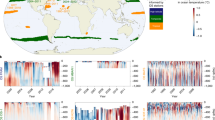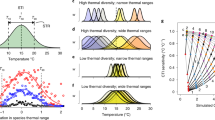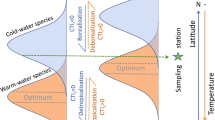Abstract
Slower warming in the deep ocean encourages a perception that its biodiversity is less exposed to climate change than that of surface waters. We challenge this notion by analysing climate velocity, which provides expectations for species’ range shifts. We find that contemporary (1955–2005) climate velocities are faster in the deep ocean than at the surface. Moreover, projected climate velocities in the future (2050–2100) are faster for all depth layers, except at the surface, under the most aggressive GHG mitigation pathway considered (representative concentration pathway, RCP 2.6). This suggests that while mitigation could limit climate change threats for surface biodiversity, deep-ocean biodiversity faces an unavoidable escalation in climate velocities, most prominently in the mesopelagic (200–1,000 m). To optimize opportunities for climate adaptation among deep-ocean communities, future open-ocean protected areas must be designed to retain species moving at different speeds at different depths under climate change while managing non-climate threats, such as fishing and mining.
This is a preview of subscription content, access via your institution
Access options
Access Nature and 54 other Nature Portfolio journals
Get Nature+, our best-value online-access subscription
$29.99 / 30 days
cancel any time
Subscribe to this journal
Receive 12 print issues and online access
$209.00 per year
only $17.42 per issue
Buy this article
- Purchase on Springer Link
- Instant access to full article PDF
Prices may be subject to local taxes which are calculated during checkout



Similar content being viewed by others
Data availability
Ocean temperature rasters for each depth layer (historical and RCPs scenarios) are available at Zenodo under the identifier https://doi.org/10.5281/zenodo.3596584. Correspondence and requests for materials should be addressed to I.B.M.
Code availability
Scripts are available at Zenodo under the identifier https://doi.org/10.5281/zenodo.3596584.
References
Poloczanska, E. S. et al. Global imprint of climate change on marine life. Nat. Clim Change 3, 919–925 (2013).
Poloczanska, E. S. et al. Responses of marine organisms to climate change across oceans. Front. Mar. Sci. 3, 62 (2016).
Pecl, G. T. et al. Biodiversity redistribution under climate change: impacts on ecosystems and human well-being. Science 355, eaai9214 (2017).
Free, C. M. et al. Impacts of historical warming on marine fisheries production. Science 363, 979–983 (2019).
Costello, M. J. & Chaudhary, C. Marine biodiversity, biogeography, deep-sea gradients, and conservation. Curr. Biol. 27, R511–R527 (2017).
Irigoien, X. et al. Large mesopelagic fishes biomass and trophic efficiency in the open ocean. Nat. Commun. 5, 3271 (2014).
Harris, P. T., Macmillan-Lawler, M., Rupp, J. & Baker, E. K. Geomorphology of the oceans. Mar. Geol. 352, 4–24 (2014).
Webb, T. J., Berghe, E. V. & O’Dor, R. Biodiversity’s big wet secret: the global distribution of marine biological records reveals chronic under-exploration of the deep pelagic ocean. PLoS ONE 5, e10223 (2010).
Cheng, L., Abraham, J., Hausfather, Z. & Trenberth, K. E. How fast are the oceans warming? Science 363, 128–129 (2019).
Desbruyères, D., McDonagh, E. L., King, B. A. & Thierry, V. Global and full-depth ocean temperature trends during the early twenty-first century from Argo and repeat hydrography. J. Climate 30, 1985–1997 (2016).
Loarie, S. R. et al. The velocity of climate change. Nature 462, 1052–1055 (2009).
Burrows, M. T. et al. The pace of shifting climate in marine and terrestrial ecosystems. Science 334, 652–655 (2011).
Pinsky, M. L., Worm, B., Fogarty, M. J., Sarmiento, J. L. & Levin, S. A. Marine taxa track local climate velocities. Science 341, 1239–1242 (2013).
García Molinos, J. et al. Climate velocity and the future global redistribution of marine biodiversity. Nat. Clim. Change 6, 83–88 (2016).
Chivers, W. J., Walne, A. W. & Hays, G. C. Mismatch between marine plankton range movements and the velocity of climate change. Nat. Commun. 8, 14434 (2017).
Jorda, G. et al. Ocean warming compresses the three-dimensional habitat of marine life. Nat. Ecol. Evol. 4, 109–114 (2020).
Burrows, M. T. et al. Ocean community warming responses explained by thermal affinities and temperature gradients. Nat. Clim. Change 9, 959–963 (2019).
Moss, R. H. et al. The next generation of scenarios for climate change research and assessment. Nature 463, 747–756 (2010).
Sayre, R. et al. A three-dimensional mapping of the ocean based on environmental data. Oceanography 30, 90–103 (2017).
Kaschner, K. et al. AquaMaps: Predicted Range Maps for Aquatic Species v.10/2019 (Global Biodiversity Information Facility, accessed 2019); https://www.aquamaps.org/
Levin, L. A. & Bris, N. L. The deep ocean under climate change. Science 350, 766–768 (2015).
Wiens, J. J. Climate-related local extinctions are already widespread among plant and animal species. PLoS Biol. 14, e2001104 (2016).
Balmaseda, M. A., Trenberth, K. E. & Källén, E. Distinctive climate signals in reanalysis of global ocean heat content. Geophys. Res. Lett. 40, 1754–1759 (2013).
Wright, G. et al. Marine spatial planning in areas beyond national jurisdiction. Mar. Policy (in the press).
Ashford, O. S. et al. Phylogenetic and functional evidence suggests that deep-ocean ecosystems are highly sensitive to environmental change and direct human disturbance. Proc. R. Soc. B 285, 20180923 (2018).
Pinsky, M. L., Eikeset, A. M., McCauley, D. J., Payne, J. L. & Sunday, J. M. Greater vulnerability to warming of marine versus terrestrial ectotherms. Nature 569, 108–111 (2019).
Hidalgo, M. & Browman, H. I. Developing the knowledge base needed to sustainably manage mesopelagic resources. ICES J. Mar. Sci. 76, 609–615 (2019).
Chen, I.-C., Hill, J. K., Ohlemüller, R., Roy, D. B. & Thomas, C. D. Rapid range shifts of species associated with high levels of climate warming. Science 333, 1024–1026 (2011).
Phrampus, B. J., Hornbach, M. J., Ruppel, C. D. & Hart, P. E. Widespread gas hydrate instability on the upper U.S. Beaufort margin. J. Geophys. Res. Solid Earth 119, 8594–8609 (2014).
Game, E. T. et al. Pelagic protected areas: the missing dimension in ocean conservation. Trends Ecol. Evol. 24, 360–369 (2009).
García Molinos, J., Burrows, M. T. & Poloczanska, E. S. Ocean currents modify the coupling between climate change and biogeographical shifts. Sci. Rep. 7, 1–9 (2017).
Brito-Morales, I. et al. Climate velocity can inform conservation in a warming world. Trends Ecol. Evol. 33, 441–457 (2018).
Venegas‐Li, R., Levin, N., Possingham, H. & Kark, S. 3D spatial conservation prioritisation: accounting for depth in marine environments. Methods Ecol. Evol. 9, 773–784 (2018).
Morgan, L., Pike, E. & Moffitt, R. How much of the ocean is protected? Biodiversity 19, 148–151 (2018).
Roberts, C. M. et al. Marine reserves can mitigate and promote adaptation to climate change. Proc. Natl Acad. Sci. USA 114, 6167–6175 (2017).
Burrows, M. T. et al. Geographical limits to species-range shifts are suggested by climate velocity. Nature 507, 492–495 (2014).
Visconti, P. et al. Protected area targets post-2020. Science 364, 239–241 (2019).
Maxwell, S. M., Gjerde, K. M., Conners, M. G. & Crowder, L. B. Mobile protected areas for biodiversity on the high seas. Science 367, 252–254 (2020).
Fredston‐Hermann, A., Gaines, S. D. & Halpern, B. S. Biogeographic constraints to marine conservation in a changing climate. Ann. NY Acad. Sci. 1429, 5–17 (2018).
Dobrowski, S. Z. et al. The climate velocity of the contiguous United States during the 20th century. Glob. Change Biol. 19, 241–251 (2013).
Dobrowski, S. Z. & Parks, S. A. Climate change velocity underestimates climate change exposure in mountainous regions. Nat. Commun. 7, 12349 (2016).
Vrac, M., Stein, M. L., Hayhoe, K. & Liang, X.-Z. A general method for validating statistical downscaling methods under future climate change. Geophys. Res. Lett. 34, L18701 (2007).
Rogers, A. D. Environmental change in the deep ocean. Annu. Rev. Environ. Resour. 40, 1–38 (2015).
Schulzweida, U. CDO User Guide v.1.9.8 (Zenodo, 2019).
R Core Team. R: A Language and Environment for Statistical Computing (R Foundation for Statistical Computing, 2018).
Tittensor, D. P. et al. Global patterns and predictors of marine biodiversity across taxa. Nature 466, 1098–1101 (2010).
Sunday, J. M., Bates, A. E. & Dulvy, N. K. Thermal tolerance and the global redistribution of animals. Nat. Clim. Change 2, 686–690 (2012).
Richardson, A. J. In hot water: zooplankton and climate change. ICES J. Mar. Sci. 65, 279–295 (2008).
Sen Gupta, A. et al. Episodic and non-uniform shifts of thermal habitats in a warming ocean. Deep Sea Res. Part II 113, 59–72 (2015).
García Molinos, J., Schoeman, D. S., Brown, C. J. & Burrows, M. T. VoCC: an R package for calculating the velocity of climate change and related climatic metrics. Methods Ecol. Evol. 10, 2195–2202 (2019).
Sunday, J. M. et al. Species traits and climate velocity explain geographic range shifts in an ocean-warming hotspot. Ecol. Lett. 18, 944–953 (2015).
Brown, A. & Thatje, S. The effects of changing climate on faunal depth distributions determine winners and losers. Glob. Change Biol. 21, 173–180 (2015).
Klein, C. J. et al. Shortfalls in the global protected area network at representing marine biodiversity. Sci. Rep. 5, 17539 (2015).
Eyring, V. et al. Taking climate model evaluation to the next level. Nat. Clim. Change 9, 102–110 (2019).
Schliep, E. M., Gelfand, A. E. & Clark, J. S. Stochastic modeling for velocity of climate change. J. Agric. Biol. Environ. Stat. 20, 323–342 (2015).
Hamann, A., Roberts, D. R., Barber, Q. E., Carroll, C. & Nielsen, S. E. Velocity of climate change algorithms for guiding conservation and management. Glob. Change Biol. 21, 997–1004 (2015).
Carroll, C., Lawler, J. J., Roberts, D. R. & Hamann, A. Biotic and climatic velocity identify contrasting areas of vulnerability to climate change. PLoS ONE 10, e0140486 (2015).
Acknowledgements
I.B.M. is supported by the Advanced Human Capital Program of the Chilean National Research and Development Agency (grant no. 72170231). A.J.R. is supported by Australian Government grant no. ARC DP190102293. J.G.M. is funded by the Tenure-Track System Promotion Program of the Japanese Ministry of Education, Culture, Sports, Science and Technology. N.A.D. is supported by the Fundación Bancaria ‘la Caixa’ Postgraduate Fellowship (LCF/BQ/AA16/11580053). C.J.K. is supported by The University of Queensland Postdoctoral Fellowship.
Author information
Authors and Affiliations
Contributions
I.B.M., D.S.S. and A.J.R. conceived the research. K.K., C.G. and K.K.R. provided the marine biodiversity data. I.B.M and D.S.S. analysed the data. I.B.M, D.S.S. and A.J.R. wrote the first draft. I.B.M., D.S.S., A.J.R., J.G.M., M.T.B., N.A.D. and C.J.K. contributed equally to discussion of ideas and analyses. All authors commented on the manuscript.
Corresponding author
Ethics declarations
Competing interests
The authors declare no competing interests.
Additional information
Peer review information Nature Climate Change thanks Conor Waldock and the other, anonymous, reviewer(s) for their contribution to the peer review of this work.
Publisher’s note Springer Nature remains neutral with regard to jurisdictional claims in published maps and institutional affiliations.
Extended data
Extended Data Fig. 1 Temporal trend component of climate velocity.
a, Temporal trend (°C decade−1) for contemporary (1955–2005) and projected sea temperatures (2050–2100) at four different depths in the ocean under three IPCC scenarios (RCP2.6, RCP4.5 and RCP8.5). b, Median climate velocity values by 1° of latitude. White bands in deeper layers represent areas where there is no water because of seafloor features extending into pelagic zones.
Extended Data Fig. 2 Spatial gradient component of climate velocity.
a, Spatial gradient (°C km−1) for contemporary (1955–2005) and projected sea temperatures (2050–2100) at four different depths in the ocean under three IPCC scenarios (RCP2.6, RCP4.5 and RCP8.5). b, Median climate velocity values by 1° of latitude. White bands in deeper layers represents areas where there is no water because of seafloor features extending into pelagic zones.
Extended Data Fig. 3 Direction of climate velocity.
Direction of climate velocity for contemporary (1955–2005) and projected future sea temperatures (2050–2100) at four different depths in the ocean under three IPCC scenarios (RCP2.6, RCP4.5 and RCP8.5). Directions standardized by hemisphere to poleward/equatorward directions.
Extended Data Fig. 4 Global changes in temperature by 2100 relative to 2019.
Global changes in temperature conditions at four different layers in the ocean by 2100 relative to present day conditions (2019) under three IPCC scenarios (RCP2.6, RCP4.5 and RCP8.5). White grid squares in deeper layers represent areas where seafloor features extending upward toward the surface mean that there are no sea temperature data available at this depth.
Extended Data Fig. 5 Species richness for three ocean layers in the ocean.
Species richness with a probability of occurrence > 0.5 for three different layers in the ocean. Polygons represent MPAs with areas > 100,000 km2 (n = 23). Grey cells represent missing species richness data for that depth layer, given the threshold for probability of occurrence.
Extended Data Fig. 6 Standard errors associated to the linear temporal trend component of climate velocity.
Standard errors (°C decade−1) associated to the linear temporal trend component of climate velocity for contemporary (1955–2005) and projected future sea temperatures (2050–2100) at four different depths in the ocean under three IPCC scenarios (RCP2.6, RCP4.5 and RCP8.5). White grid squares in deeper layers represent areas where seafloor features extending upward toward the surface mean that there are no sea temperature data available at this depth.
Extended Data Fig. 7 Interquartile range of climate velocity among models.
Interquartile range (75th–25th) of climate velocity among models (n = 11) for contemporary (1955–2005) and projected future sea temperatures (2050–2100) at five different depths in the ocean and under three IPCC scenarios (RCP2.6, RCP4.5 and RCP8.5). White grid squares in deeper layers represent areas where seafloor features extending upward toward the surface mean that there are no sea temperature data available at this depth.
Supplementary information
Supplementary Information
Supplementary Tables 1–4.
Rights and permissions
About this article
Cite this article
Brito-Morales, I., Schoeman, D.S., Molinos, J.G. et al. Climate velocity reveals increasing exposure of deep-ocean biodiversity to future warming. Nat. Clim. Chang. 10, 576–581 (2020). https://doi.org/10.1038/s41558-020-0773-5
Received:
Accepted:
Published:
Issue Date:
DOI: https://doi.org/10.1038/s41558-020-0773-5
This article is cited by
-
Natural warming differentiates communities and increases diversity in deep-sea Ridge Flank Hydrothermal Systems
Communications Biology (2024)
-
Cross-basin and cross-taxa patterns of marine community tropicalization and deborealization in warming European seas
Nature Communications (2024)
-
Early detection of anthropogenic climate change signals in the ocean interior
Scientific Reports (2023)
-
Hidden heatwaves and severe coral bleaching linked to mesoscale eddies and thermocline dynamics
Nature Communications (2023)
-
Marine biodiversity exposed to prolonged and intense subsurface heatwaves
Nature Climate Change (2023)



